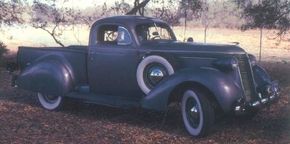The 1937-1938 Studebaker Coupe-Express was years ahead of its time, but one of the most innovative commercial vehicles in history was no commercial success.
As a car-pickup hybrid, the 1937-1938 Studebaker Coupe-Express predicted by decades the Ford Ranchero and Chevrolet El Camino of the 1950s. The 1937-1938 Studebaker Coupe-Express successfully melded car-like comfort and styling with pickup stamina and utility. It did not, as Studebaker hoped, tap an unmet need in the marketplace.
Advertisement
From the cab forward, the 1937-1938 Studebaker Coupe-Express pickup was much like Studebaker's Dictator coupe. But behind the passenger cabin sat a double-wall pickup box capable of hauling up to half a ton.
Advertising for the 1937-1938 Studebaker Coupe-Express stressed its strong, all-steel construction and roomy, comfortable cab with passenger-car appointments.
For example, the seat, ceiling, and door panels were upholstered in cloth (leather was a no-cost option) and the seatback was adjustable. Dual wipers, sun visor, safety glass, and rearview mirror were standard; so were rotary door locks for safety and easier closing.
Studebaker proclaimed that the "fully streamlined open pickup body is built entirely of 16-gauge steel with outer and inner panels, combining strength and rigidity with smart, modern appearance.
The 1937-1938 Studebaker Coupe-Express was lively, too, with ample power in 1937 from an 86-bhp, 217-cid six and then in 1937 from the 90-bhp 226 Commander six.
Styling of the 1937 Studebaker Coupe-Express was outstanding, as well -- especially for a pickup. Grille, hood, cab, and fender lines were in flowing harmony. And in line with its "posh truck" image, the 1937 Studebaker Coupe-Express had chrome bumpers at both ends, and a sidemount spare in the right front fender.
For 1938, styling was revised by the famed Loewy Studios. Studebaker's 1938 car lineup also got a facelift from the Loewy Studios, which was on contract to Studebaker and responsible for most Studebaker car and truck designs from 1938 to 1956.
The 1938 Studebaker Coupe-Express revisions included a prow-front grille in place of the previous slim, lateral-bar radiator. However, the 1938 Coupe-Express eschewed the passenger models' new faired-in headlamps, retaining 1937's pod-mounted units.
The 1938 Studebaker Coupe-Express restyle also brought a shorter hoodline that reduced clearance between the doors and the trailing edges of the front fenders. A $44.50 "standard accessory group" included a sidemount spare in the right front fender, bumper guards, and passenger-side windshield wiper. Unfortunately, 1938's shorter hood forced the sidemount tire to sit above hood level, making it look like an afterthought.
Other 1938 options were genuine leather upholstery, a metal tire cover, vacuum-control gearshift, "Hill-Holder" clutch, and overdrive with freewheeling.
Despite good looks, fine performance, and a workable combination of comfort and utility, sales of the 1937-1938 Studebaker Coupe-Express were poor. Production of the Studebaker Coupe-Express peaked in 1937 at between 3,500 and 3,800 vehicles (sources differ); 1938 saw only about 1,000 copies built.
Advertisement
